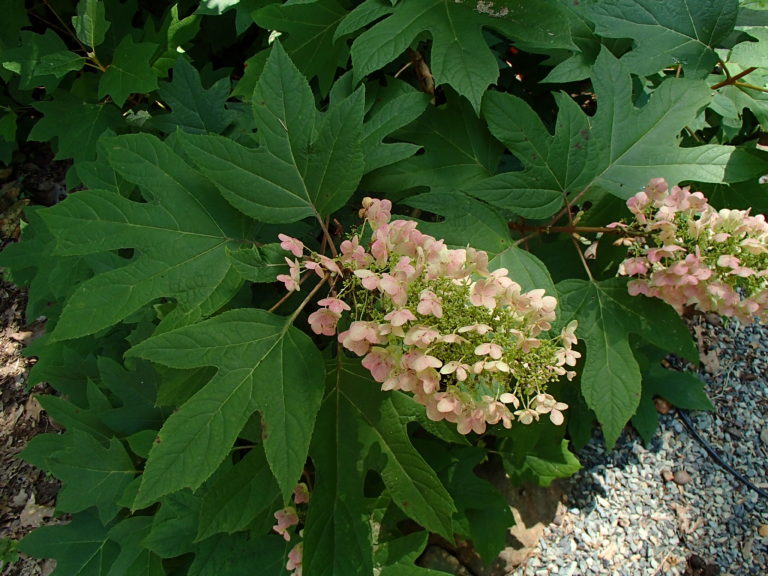Oakleaf Hydrangea, the quintessential flowering shrub for the native garden, is a deciduous shrub native to our southeastern states with outstanding ornamental value. Its growth form is broad, rounded, with lower stems sweeping the ground; with beautiful exfoliating bark and bold, handsomely lobed, deep green leaves, holding aloft great pyramidal, fragrant flowerheads covered with creamy white showy sterile flowers and less apparent fertile flowers. The flowers persist through fall and into winter, slowly taking on shades of pink as the supporting leaves take on hues of wine, mahogany and orange. The flowers eventually dry to tan, in winter. On top of all this, the plant is easy to grow in slightly acid to circumneutral, organic soil and is happiest in part shade. Oakleaf Hydrangea is basically trouble free, needing only minor pruning of winter-damaged branches in spring. It sends up offspring nearby which are easily dug and shared with friends. There are a large number of cultivars in the trade, often of smaller stature and/or brighter pink, showier flowers, but it is the non-showy fertile flowers that pull in the buzzing insects.
NURSERY HOURS
Wednesday: 10-4 Thursday: 10-6 Friday-Saturday: 10-4 Sunday: 12-4
Hydrangea quercifolia

Key Info
Scientific Name: Hydrangea quercifolia W. Bartram
Common Names: Oakleaf Hydrangea
Family Names: Hydrangeaceae (Hydrangea Family)
Plant Type: Tree / Shrub
Leaf Retention: Deciduous
Flower Color: White, Pink/rose
Additional Info
Habit: Multi-stemmed, suckering woody shrub with lower branches arching to the ground; the texture is coarse, the leaves large (larger in the shade). Larger stems have attractive cinnamon-tan-orange bark that shreds and peels in thin flakes. Flowering heads persist into winter.
Height: 6' to 8'
Spread: 6' to 8'
Soil Conditions: Organically rich, medium moisture, well-drained, acidic to neutral soils; sandy loamy, clay.
Leaves: Leaves are opposite, large (4-12 inches long and almost as wide, and smaller in full sun), simple, leathery, 3-7 lobed, oak-like leaves. They are fuzzy when young, dark green on top and silvery-white and pubescent underneath. Colors are red, bronze and purple in autumn and leaves persist into winter accompanying the dried flower-heads.
Flowers (or reproductive structures: On the branch tips, flowerheads develop in June: 4-12-inch, fragrant, erect panicles that are cone-shaped, with an outer layer of larger, showy, white sterile flowers nearly covering the creamy miniature fertile flowers underneath. The sterile flowers shade into pink, to bronzy pink, to dry, papery rusty-brown then finally fade to tan. The fertile flowers gradually transition to fruiting bodies during the summer. Flower color does not vary with soil pH.
Fruit: Many small, brown dry capsules, not showy, persistent, but not ornamentally significant;.
Natural Distribution: Oakleaf Hydrangea grows in mixed hardwood forests, along streams and on damp, forested hillsides, often on calcareous soils.
USDA Hardiness Zone: 5 - 9
USDA Wetland Indicator Status in NC: Not available
Pollination: "Everything from beetles to bees visit their flowers. From the moment they open until the last one is fertilized, these shrubs (Hydrangeas) are buzzing with activity. " (Indefenseofplants.com)
Wildlife Connections: Oakleaf Hydrangea flowers are attractive to butterflies and other insects. Songbirds eat the seeds. "Mophead" hydrangeas do not support insects as the flowers are completely sterile. The native hydrangeas present showy, sterile flowers as a come-on for the insects to visit the non-showy, fertile flowers in the same inflorescence.
Propagation: This plant is usually propagated by cuttings or by digging up rooted suckers or by layering.
